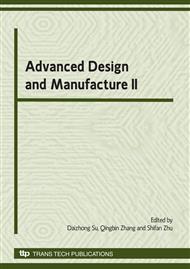p.57
p.61
p.65
p.69
p.73
p.77
p.81
p.85
p.89
Description of Work-Hardening Layer’s Depth by Soft Coefficient
Abstract:
In this paper, by introducing the conceptions of stress condition and soft coefficient, a nonlinear equation is used to describe stress condition of the contacting body along depth. By taking the classical contact problem of two parallel cylinders as an example, we give a quantitative description of work-hardening layer’s depth related to local contact problems by using soft coefficient, and it is theoretically proved that plastic deformation and plastic failure exist objectively in engineering contact problem. The analysis indicates that hardening layer’s depth in the range of 0.43643b(where “b” represents contacting semi-width ), where soft coefficient equivalents to infinity, can be defined as "work-hardening surface layer", depth ranging from 0.43643b to 3b can be roughly defined as "subsurface layer", and depth ranging out of 3b can be defined as "deep layer". Finite element analysis of Ono-rolling specimen shows that measuring method of x-ray of the residual stress is relatively more accurate in the surface layer; however, numerical method can give more accurate results than experimental method in the subsurface and deep layer.
Info:
Periodical:
Pages:
73-76
Citation:
Online since:
October 2009
Authors:
Keywords:
Price:
Сopyright:
© 2010 Trans Tech Publications Ltd. All Rights Reserved
Share:
Citation:


